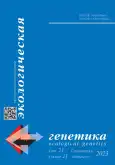Teaching interdisciplinary courses on responsible conduct in the life sciences — implications for biorisk assessments of GMOs
- Authors: Himmel M.1, Malygina A.A.2, Dukhinova M.S.3
-
Affiliations:
- Independent Lecturer in Bioethics and Biosecurity
- Saint Petersburg State University
- SCAMT Research Institute, ITMO University
- Issue: Vol 21 (2023): Спецвыпуск
- Pages: 71-72
- Section: Genetically modified organism. The Нistory, Achivements, Social and Environmental Riscs
- Submitted: 17.08.2023
- Accepted: 31.08.2023
- Published: 04.12.2023
- URL: https://journals.eco-vector.com/ecolgenet/article/view/568584
- DOI: https://doi.org/10.17816/ecogen568584
- ID: 568584
Cite item
Full Text
Abstract
Genetic engineering is a powerful set of methods used in basic research, biomedicine, and biotechnology. In the molecular biology laboratory, there are established standards in biosafety to protect humans and the environment from unwanted consequences of genetic engineering although internationally agreed, legally binding biosafety standards have not been developed yet. The World Health Organisation as one international actor provides a “Laboratory Biosafety Manual” outlining key biosafety standards and a “Guidance framework for the responsible use of the life sciences” to foster biorisk assessment strategies which could be implemented by national research institutions [1, 2]. Practitioners in both the life sciences and in biotechnology should be trained in comprehensive biorisk assessments which would also further strengthen the implementation of the international agreement on banning biological weapons [3]. Recently, we reported about lessons learned from conducting two iterations of an international interdisciplinary online workshop on responsible conduct in the life sciences [4]. Here, we provide insights from the third workshop and the impact of the lessons learned from this long-standing workshop series on the own work in the molecular biology laboratories of the organisers in respect to biorisk assessments and science communication.
Keywords
Full Text
Genetic engineering is a powerful set of methods used in basic research, biomedicine, and biotechnology. In the molecular biology laboratory, there are established standards in biosafety to protect humans and the environment from unwanted consequences of genetic engineering although internationally agreed, legally binding biosafety standards have not been developed yet. The World Health Organisation as one international actor provides a “Laboratory Biosafety Manual” outlining key biosafety standards and a “Guidance framework for the responsible use of the life sciences” to foster biorisk assessment strategies which could be implemented by national research institutions [1, 2]. Practitioners in both the life sciences and in biotechnology should be trained in comprehensive biorisk assessments which would also further strengthen the implementation of the international agreement on banning biological weapons [3]. Recently, we reported about lessons learned from conducting two iterations of an international interdisciplinary online workshop on responsible conduct in the life sciences [4]. Here, we provide insights from the third workshop and the impact of the lessons learned from this long-standing workshop series on the own work in the molecular biology laboratories of the organisers in respect to biorisk assessments and science communication.
About the authors
Mirko Himmel
Independent Lecturer in Bioethics and Biosecurity
Email: mirko.himmel@yahoo.de
Germany, Hamburg
Anastasia A. Malygina
Saint Petersburg State University
Email: a.malygina@spbu.ru
SPIN-code: 9080-4120
Associate Professor, Strategic and Arms Control Studies Master’s Program
Russian Federation, Saint PetersburgMarina S. Dukhinova
SCAMT Research Institute, ITMO University
Author for correspondence.
Email: dukhinova@scamt-itmo.ru
ORCID iD: 0000-0001-8118-9439
SPIN-code: 2266-3810
Laboratory of Experimental Oncology and Immunology
Russian Federation, Saint PetersburgReferences
- World Health Organization. (2020). Laboratory Biosafety Manual. Available from: https://www.who.int/publications/i/item/9789240011311.
- World Health Organization. (2022). Global guidance framework for the responsible use of the life science. Available from: https://apps.who.int/iris/handle/10665/362313.
- Biological Weapons Connvention. (2006). Sixth Review Conference of the States Parties to the Convention on the Prohibition of the Development, Production and Stockpiling of Bacteriological (Biological) and Toxin Weapons and on Their Destruction. Final Document. BWC/CONF.VI/6. Paragraph 14. Available from: https://www.un.org/disarmament/publications/library/bwc
- Himmel M, Malygina AA, Dukhinova MS. Biorisk assessment of genetic engineering — lessons learned from teaching interdisciplinary courses on responsible conduct in the life sciences. Ecological genetics. 2022;20(Suppl.1S);56–57. doi: 10.17816/ecogen112361
Supplementary files










